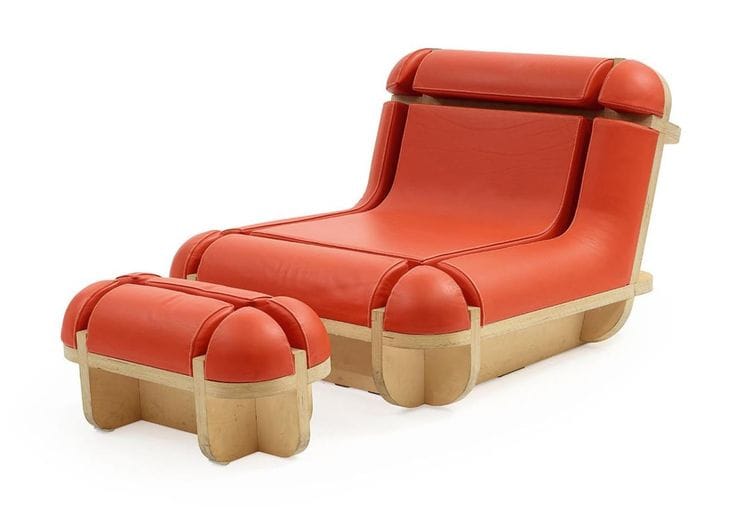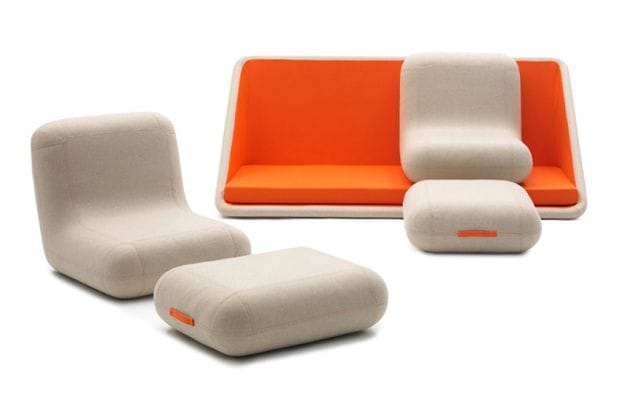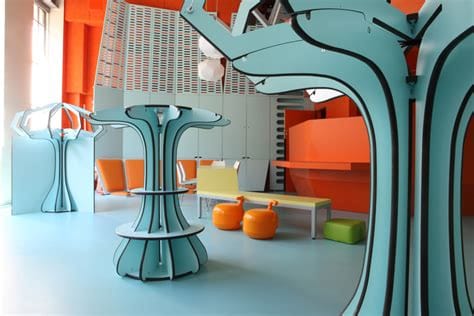Matali Crasset: The Architect of Modular Daily Life
Who is Matali Crasset?
The design of Nathalie Crasset, known as Matali Crasset, emerged in the 1990s around highly eclectic themes, notably the rejection of pure form and the exploration of new functional approaches. Her work is organized around three fundamental principles: modularity, appropriation and flexibility, which constitute the foundation of her creative philosophy. In 1998, she took a decisive step by creating her company, Matali Crasset Production, allowing her to fully express her singular design vision.

The diversity of her creations testifies to her ability to invest in numerous fields. In 2007, her “Love Toy” achieved resounding success, illustrating her bold approach and ability to reinvent everyday objects. International recognition of her work materializes through the presence of some of her creations in the prestigious collections of the MoMA in New York and the Museum of Decorative Arts in Paris.
An Exceptional Collaboration with Pierre Hermé for Alessi (2010)
This collection born from the collaboration with the famous pastry chef Pierre Hermé reveals Matali Crasset’s methodical approach.

“I decided to define a scenario of clear uses for each instrument,” she explains, “with the main objective of maintaining the simplicity I had observed in pastry utensils. I therefore designed objects that are both professional and generous, and by that I mean they are also accessible to non-specialists.”
Each piece in the collection reflects this philosophy of democratic accessibility of design. Thus, for one of the presentation dishes: “This dish is a pedestal. It serves to place pastry in the spotlight, and is, in this sense, an invitation to become a gourmet. The colors have been developed so that the radiant harmony that emerges is both lively and stimulating.”
Iconic Creations: From Modular Furniture to Architectural Installations
“Concentré de Vie” Sofa 2008 – Transformable furniture for a changing life
Created by Matali Crasset for the Italian publisher Campeggi, the “Concentré de Vie” is much more than a simple sofa: it’s a compact living space, an autonomy cell, designed to accommodate multiple daily uses in a restricted volume.
Matali Crasset imagines here a nomadic and modular piece of furniture, faithful to her vision of functional, participatory and evolving design. The sofa unfolds like origami: it reveals a coffee table, an extra bed, secondary seating, integrated storage… each element has its place, each function can be activated or folded according to need.

Its lively and playful aesthetic — simple geometric forms, bold colors — evokes a domestic micro-architecture, conceived as an active nucleus around which life gravitates. It’s an intelligent response to small urban spaces and a manifesto of design as a life facilitator.
Cité des Petits / Maison des Petits 2009 – Playful and participatory educational center
At the heart of CENTQUATRE, Matali Crasset designs a revolutionary educational space for children. The installation consists of modules reminiscent of colorful trees, creating an environment that is both playful and educational. Each element becomes a support for learning, exploration and free play.
This realization testifies to the designer’s social commitment: design as a tool for development and inclusion. The living space she creates promotes children’s autonomy while stimulating their creativity, perfectly embodying her vision of participatory design.

Dynamic Life Sofa 2011 – Innovation in service of modular comfort
Presented at the Milan Furniture Fair in 2011, the Dynamic Life perfectly embodies Matali Crasset’s modular vision. This revolutionary sofa offers seating composed of individually articulated cushions, capable of folding to free up space or deploying to transform into a sofa-bed or chaise lounge.
Technological innovation is not lacking: controlled by an intuitive touch pad, the system allows three different configurations, offering the user unprecedented freedom of adaptation according to their needs and desires of the moment.

ReflexCity Pods 2016 – Sculptural participatory cabins
At the Asia Culture Center in Gwangju, Matali Crasset installs pod-like architectural modules that combine sculptural design and social function. These rest, study and contemplation cabins redefine the cultural center experience.
Each pod becomes a personal micro-territory within the collective space, illustrating Crasset’s ability to create object-architectures that respond to contemporary needs for flexibility and intimacy in public space.
Le Rainbow et Le Bosquet 2020 – Apartment renovation transformed into a colorful landscape
In this Parisian apartment project, Matali Crasset revolutionizes traditional housing by creating a dynamic domestic landscape. The centerpiece: a sculptural rainbow partition that redefines circulation and perspectives. This chromatic intervention is accompanied by colored modules that reinvent each function of the domestic space.

The project perfectly illustrates Crasset’s approach: transforming habitat into experiential playground, where bold colors and organic forms create a renewed domestic geography. Each colored zone corresponds to a specific use, but the fluidity of the whole allows free and evolving appropriation.
Archipel Tonique 2020 – Modular furniture in an atrium designed by Renzo Piano
In the spectacular atrium of the ENS Paris-Saclay campus designed by Renzo Piano, Matali Crasset deploys an immersive installation called Archipel Tonique. Composed of mobile loop modules in green and orange, this creation evokes an archipelago in perpetual motion, transforming the academic space into a playful and adaptable landscape.
These sculpture-furniture pieces invite students to reappropriate the space according to their needs: collaborative work spaces, relaxation areas or simple contemplation supports. Crasset’s intervention transcends the decorative function to create a true playful architecture, where each module becomes a catalyst for sociability.
The Essence of Crasset Design: Between Sculpture, Context and Sociability
These major creations illustrate the sculptural, contextual and social dimension of Matali Crasset’s design. Each project transcends the object: furniture, architecture or installation become tools for collective and sensitive living. Crasset’s approach is both playful and rigorous, mixing bold colors, graphic forms and functional modularity.
Through these emblematic creations, Matali Crasset outlines the contours of contemporary design where modularity becomes the vector of a renewed relationship between object and user, making each creation an invitation to reinvent one’s daily life.
To learn more:
- Explore the Centre Pompidou and its collaborations with Matali Crasset
- Discover other design icons who have marked the history of contemporary design
- Visit the Victoria and Albert Museum to discover other contemporary designers
